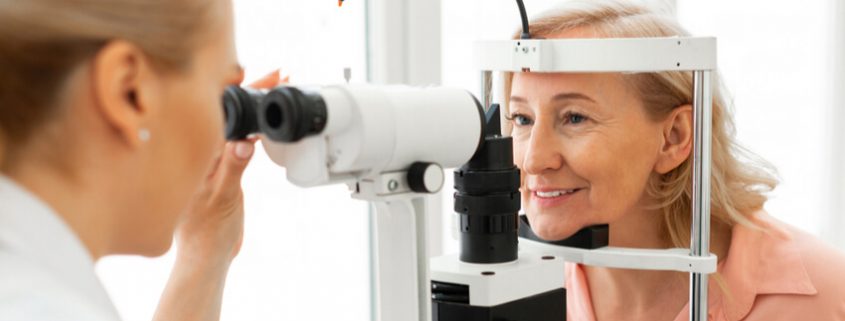What Do Cataracts Look Like? Discover If You Need Cataract Surgery
As cataract surgery is one of the most commonly performed operations in the world, it is likely you’ve heard of cataracts before. Despite their ubiquitous nature, many people are unfamiliar with how cataracts are detected. If you’re wondering what do cataracts look like and whether you might have one that needs cataract surgery, keeps reading.
What Do Cataracts Look Like? – Discover it from an Eye Doctor
If you’re looking at yourself in a mirror, you’re not likely to notice anything different about your eyes. A cataract forms behind the coloured iris, making it difficult to see through a normal pupil (the aperture in the middle of your iris) without the appropriate equipment. However, in some cases, you may be able to catch a glimpse of a whitish glint in the pupil of another person with a cataract if you’re looking at the right angle. This is a clinical sign known as leukocoria, which refers to a white pupil. As a side note, leukocoria may also be a sign of other eye conditions, including retinal cancer or a lazy eye in children, and so should never be ignored.
You’re more likely to suspect you have a cataract from its associated visual symptoms. What do cataracts look like in your vision? The symptoms of a cataract can vary from individual to individual and can depend on the density and location of the cataract opacity. You may experience symptoms such as:
- Deteriorating visual clarity. Although blurry vision is a common effect of cataracts, not everyone will identify their vision as blurry. Instead, common descriptors for the vision experienced through a cataract include hazy, filmy, or cloudy. Some individuals may feel as though they’re looking through a dirty window or permanently smudged glasses lenses. This can translate to difficulty in recognising faces from down the street or reading the fine print on ingredient labels or medications.
- Increasing glare sensitivity. As the opacity of a cataract scatters light entering the eye, our eye perceives this as glare or dazzle. Depending on the location of the cataract within the lens, glare sensitivity can range from mild irritation to debilitating glare that prevents a person from performing their usual activities. You may find oncoming car headlights to be overly dazzling or you need to reduce the brightness of your screen to view it more comfortably.
- Decreasing contrast sensitivity. Another effect of a growing cataract is that your ability to discern differences, in contrast, is impaired. This can mean reading coloured text against a coloured background is increasingly difficult, or you need much brighter lighting to read any text clearly compared to several years ago. Some people may also find they have disproportionate difficulty seeing the road or cars ahead when visibility conditions are low, such as during foggy mornings or heavy rain.
Other signs that might alert you to the presence of a cataract are a change to your colour vision or frequent prescription changes to your glasses or contact lenses. It’s important to note that none of these symptoms is unique to cataracts, and can potentially indicate other eye conditions that aren’t treatable with cataract surgery. What do cataracts look like? If you’re ever concerned about your eyes or the state of your sight, see your optometrist or ophthalmologist.
What Does Cataract Look Like to An Eyecare Professional?
Cataracts are diagnosed by an optometrist or ophthalmologist. In many cases, cataracts are detected during a routine exam, even before you notice any changes to your vision. After conducting an examination, your eye care professional will be able to discuss their advice around cataract surgery.
 Your optometrist or ophthalmologist will use a few tests to diagnose a cataract. They will typically start with taking the history of your visual symptoms if you have any. Cataracts are known to be relatively slow-growing, so if you report waking up with sudden vision deterioration, your eyecare professional will know it’s not due to a cataract. It’s also important for your optometrist or ophthalmologist to get an idea of how the cataract might be impacting your daily activities and lifestyle as this may guide their recommendation around the timing of cataract surgery. For example, if you enjoy birdwatching, an early cataract is likely going to bother you at a much earlier stage compared to someone who just prefers to watch TV. Or if you’re a painter and rely on accurate colour vision, your cataracts will be more problematic and are more likely to require early cataract surgery compared to someone whose colour perception has no bearing on their usual tasks.
Your optometrist or ophthalmologist will use a few tests to diagnose a cataract. They will typically start with taking the history of your visual symptoms if you have any. Cataracts are known to be relatively slow-growing, so if you report waking up with sudden vision deterioration, your eyecare professional will know it’s not due to a cataract. It’s also important for your optometrist or ophthalmologist to get an idea of how the cataract might be impacting your daily activities and lifestyle as this may guide their recommendation around the timing of cataract surgery. For example, if you enjoy birdwatching, an early cataract is likely going to bother you at a much earlier stage compared to someone who just prefers to watch TV. Or if you’re a painter and rely on accurate colour vision, your cataracts will be more problematic and are more likely to require early cataract surgery compared to someone whose colour perception has no bearing on their usual tasks.
Your eyecare practitioner will be able to examine your cataracts directly with an instrument called a slit lamp, which is comprised of a light source and magnification system that allows your optometrist or ophthalmologist to view various structures of the eye. Behind a slit lamp, your clinician will be able to see the density and location of the cataract.
Age-related cataracts fall into three general categories, but often you may have more than one type at the same time. Nuclear sclerosis appears as a yellow-brown haze in the core of the lens while anterior cortical cataracts appear as greyish spokes radiating from the edge of the lens inwards. Through a slit lamp, a posterior subcapsular cataract looks like a dense white plaque on the back surface of the lens.
In order to appropriately advise you on the timing of cataract surgery, your eye care professional will also test your visual acuity, which involves reading black letters of decreasing size against a white background. Even though you may not reach the standard “20/20 vision”, it doesn’t mean you necessarily require immediate cataract surgery, especially if you are still content with your vision. Speak to your eye care professional at (03) 9070 3580 if you are concerned.






Leave a Reply
Want to join the discussion?Feel free to contribute!